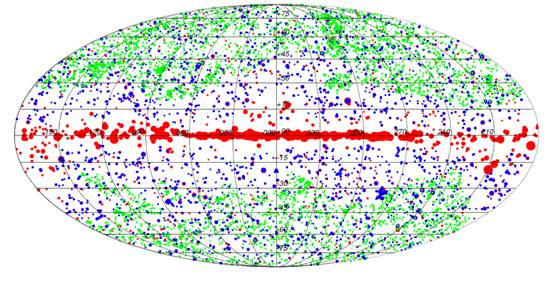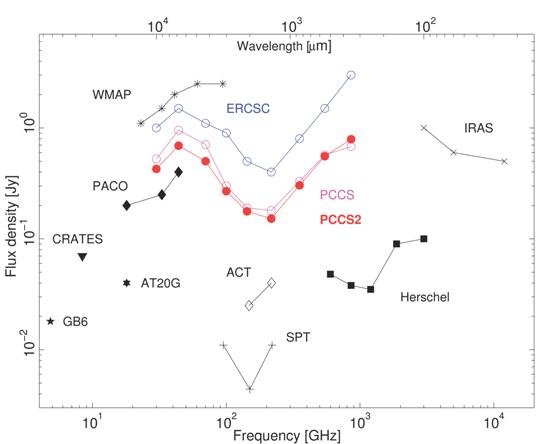Submitted by Dr. Eloy de Ler... on Fri, 28/08/2015 - 10:57

“Full sky location of the sources in the PCCS2 using a Mollweide projection. The equator line in this picture matches the Milky Way central disc edge on. Longitude increases to the left with the Milky Way centre in the centre of the picture. The circles, Red (30 GHz), Blue (143 GHz) and Green (857 GHz) relative sizes give and idea about how bright the sources are as “seen” by Planck”
ESA's Planck telescope set out to measure tiny fluctuations in the Cosmic Microwave Background (CMB) – the thermal footprint left by the Big Bang. To achieve this, it continuously scanned the sky, detecting CMB jointly with the foreground emissions arising from cosmic structures lying between the CMB and ourselves. These foreground structures had to be carefully mapped and characterised as they act as contaminants of the CMB. This endeavour has resulted in a valuable by-product: a full sky extensive catalogue of individual compact sources observed in nine different frequencies ranging from the radio (30 GHz) up to the sub-millimetre (857 GHz).
The Second Planck Catalogue of Compact Sources (PCCS2; 2015) is now the third catalogue of compact objects released by the Planck Consortium after the Early Catalogue (2011) and the Nominal Mission Catalogue (2013). This new eagerly waited catalogue contains tens of thousands of compact sources and it surpasses its predecessors not only in quantity but mostly in the quality of the released data. The catalogue was constructed using data from the entire Planck mission (2009 to 2013) and the newest much improved processing tools and data pipelines. In addition, it also contains polarisation information for several hundreds of sources extracted from seven (30 GHz - 353 GHz) of the nine Planck observing channels.
One of the main goals of this “Planck product” development was flexibility. The catalogue was designed to serve a large and varied community of astronomers, often with opposite preferences, and not only cosmologists. So, an extra effort was committed to define, characterise and organise several sub sets of the catalogue each one “flavoured” and aimed at a different group. There is a set of sources, with less conventional signatures, mostly directed for follow-up activities. A set of radio sources, the preferred of radio astronomers, which were already known, but which have never been observed before at Planck’s wavelengths. And the cosmological set, properly constructed and characterised, to support Planck’s primary goal: CMB detection.
The construction of this catalogue was a challenging task full of difficulties. One of its main goals was a proper and complete characterisation of the catalogue “completeness”. Completeness is a quantity that allows us to predict how many objects of a certain kind exist given those the instrument observed. This quantity is pivotal for cosmologists to develop and constrain their models of the Universe and its evolution. However in between ourselves and the catalogue objects stands our own galaxy. At Planck’s sensitivity and resolution it became extremely complex to tell apart whether a certain object is indeed a galaxy sitting in the background, the object of interest, or merely a knot of dust from our neighbourhoods. This goal could only be achieved by employing state-of-the-art data analysis tools and simulations, using thousands of processors in a super computer.
The improvements in data quality and processing algorithms are just part of the reason why this catalogue is a major improvement over those Planck catalogues that came before. Planck has polarisation sensitive instruments in seven frequencies it observes in: 30 GHz – 353 GHz, and, unlike its predecessors, this catalogue contains polarisation data for several hundred compact sources. By adding polarisation information to other intensity based measurements, like the spectral energy distribution, deeper and more robust models of the physics of those objects can now be tested.
This new Planck Catalogue of Compact Sources represents a lasting legacy that will seed new exciting findings all across the astronomy community.

“Sensitivity of the Second Planck Catalogue of Compact Sources (PCCS2) compared with Planck Nominal Mission Catalogue (PCCS), Planck Early Catalogue (ERCSC), Wilkinson Microwave Anisotropy Probe (WMAP) and others experiments. The “X” axis shows the central frequencies (equivalent wavelength at the top) of the different channels and the “Y” axis a measurement about how sensitive the experiment is to faint sources (lower values mean better suited to detect faint objects)”
Pedro Carvalho

